Captivated by Crackle Glass
Story by Donald-Brian Johnson; Photos by Leslie Pina
“Look, look, look to the rainbow-
Follow it over the hill and stream.
Look, look, look to the rainbow-
Follow the fellow who follows a dream.”
E.Y. “Yip” Harburg – Finian’s Rainbow, 1947
You’ve seen the magic. The day is dreary. A stray sunbeam wends its way through a cloudy sky. It makes a perfunctory pass along your window, illuminating a shelf filled with assorted glass bottles and vases. Then, without warning, a dazzling display of refracted light fills the room. And not just any light. Sometimes it’s red. Sometimes it’s orange. Sometimes it might be yellow – or green – or perhaps even blue. An entire rainbow is at your visual service, each ray cavorting in a myriad of patterns. All at once, that dreary day isn’t so dreary after all. The miracle has happened. And the miracle-maker? Crackle glass!
Home decorating schemes of the mid-twentieth century were often distinguished by at least one of these lustrous light-catchers. While the glass-making technique for crackle glass was developed in 16th century Venice, crackle glass experienced an amazing level of popularity during the period we now call Mid-Century Modern. The modern art take on crackle glass reached its zenith in the swinging ’60s, as fans of Mad Men and related retro flashbacks can attest. The lines of crackle glass were clean and uncluttered; the varied shapes captured and held interest. The colors-whether bold or clear, solids, shaded, iridescent or extreme contrasts-made each piece the ideal complement to ultra-modern décor. Even the starkest postwar environment called out for a stimulating focal point. Cool and colorful crackle glass was on hand to unfussily provide it.
Crackle glass comes in all varieties and price ranges, from dime-store dazzlers to expensive eye-catchers. The reason: crackle glass is a treatment, rather than a style. It’s pretty much adaptable to any type of sufficiently sturdy glass (even marbles can be “crackled” on the kitchen stove). The “crackling” finish is created when a hot glass object is submerged in cold water; the abrupt temperature change cracks the glass. The object is then reheated to seal the cracks and strengthen and smooth the glass. Once the process is complete, crack lines (“crackling”) remain. Because of the irregularity of the crackling, light shining on crackle glass deflects on other surfaces in those ever-intriguing patterns. The result: up-to-the-minute stylishness, achieved with a minimum of effort.
At first, crackle glass was almost always hand-made and mouth-blown. Its popularity quickly led to less-expensive molded crackle glass, imported knockoffs of pricey domestic designs. The crackling was still there, even if originality and attention to detail were not.
Because any glass manufacturer could utilize the crackling treatment, almost every manufacturer did. While some companies, such as Tiffin, Duncan, and Imperial only dabbled in crackle glass production, others made it a specialty. The most notable crackle glass firms were located in West Virginia. Among them were Pilgrim, Rainbow, and Kanawha, especially noted for their “miniatures” (jugs, pitchers, and vases); Viking, which included limited crackle in its array of quality glassware; and Bischoff, best categorized as a determinedly prolific copyist. The kingpin of them all, however, still resonates resoundingly as an emblem of mid-twentieth century glass design: that master manufacturer of crackle glass on a jumbo scale, Blenko.
Originally known for architectural stained glass, the Blenko name has today become synonymous with the firm’s richly-colored, oversized art glass vessels. Blenko was founded in the early 1920s by glass craftsman William John Blenko, who had arrived from London in the mid-1890s. The market for handcrafted stained glass bottomed out when the Depression hit America in 1929, and Blenko was forced to seek out other revenue sources. The founder’s son, William H., came up with the idea of expanding glassware production to include affordable decorative housewares, such as bottles and vases. The company’s previous expertise with stained glass came in particularly handy here, leading to the development of the extensive color palette that contributed much to the Blenko reputation.
Crackle glass first entered the Blenko catalogs in 1946, although it had been produced in limited quantities before then. To attract the largest customer base, the same pieces were often released in both crackle and non-crackle finishes. Although other manufacturers specialized in crackle glass miniatures, Blenko pieces were invariably full-sized (and then some). Any Blenko miniatures were usually mini-versions of regular-scale releases.
The heyday of Blenko crackle glass was the 1950s and ’60s. During that time, the creations of three specific glass artisans contributed much to the Blenko reputation:
Winslow Anderson: Blenko’s first full-time designer, Anderson was with the firm from 1947-1952. Trained as a ceramist, his award-winning Blenko designs were noted for their “modern” shapes, (such as the bent-neck decanter), and vivid colors. He left the company for a design position with Lenox China. Since Lenox also owned Brice Glassware Company, Anderson was able to apply his design skills to both mediums.
Wayne Husted: Blenko’s design director from 1952 until 1963, Husted was responsible for literally hundreds of the company’s designs during that period. Husted also designed and photographed the Blenko catalogs, which have become collectibles in their own right (and an invaluable means of authenticating Blenko designs). His post-Blenko career included stints with Viking and Anchor Hocking. Husted is best known for the super-sized decanters and bottles that many associate with the concept of Blenko crackle glass.
Joel Philip Myers: Serving as Blenko’s design director from 1963 to 1970, Myers was also a skilled glass blower. Among his signature techniques at Blenko were the use of elongated forms, varied surface textures and applied glass spirals; two-color designs; and air-twist stoppers. His later career included founding the Department of Glass at Illinois State University.
Although the best-known, Blenko, as noted, wasn’t the only glass manufacturer cashing in on crackle glass. Among Blenko’s competitors (and often imitators):
Pilgrim: Pilgrim Glass Corporation of Ceredo, West Virginia, was founded in 1949 by Alfred Knobler. Although trained as a ceramic engineer, Knobler came to the rescue of the faltering Tri-State Glass Company in nearby Huntington. His purchase proved profitable. Knobler’s newly-renamed “Pilgrim Glass” found immediate success with its use of gleaming colors, and particularly an “onion crackle” technique which produced an extremely fine line pattern in the glass.
Heading up the Pilgrim design team were Italian imports Alessandro and Roberto Moretti, and their brother-in-law Mario Sandon. In addition to crackle glass, Pilgrim was also renowned for Venetian-influenced glass figurines and animals, and a series of “satin glass” (de-glossed) items.
Rainbow: What better name for a glass company than “Rainbow?” Based in Huntington, West Virginia, the Rainbow Art Glass Company, a Viking subsidiary, made its debut in 1939 as a glass decorating firm. Hand-blown glass became Rainbow’s specialty in 1954.
While Rainbow’s crackle glass is similar to that produced by its contemporaries, there are several Rainbow hallmarks. Among them: the use of oversize round or teardrop stoppers, and a flat collar at the neck of each bottle. Since Rainbow continued to produce crackle glass into the 1970s, well beyond the production life of its competitors, greater quantities of Rainbow abound on today’s secondary market.
Kanawha: Founded in 1953 by a corps of workers from the defunct Dunbar Glass Company of Dunbar, West Virginia, Kanawha Glass borrowed its company name from that of a nearby river. Kanawha’s crackle glass proved so popular that, during the firm’s 1960s heyday, customers could choose from over 350 production items, available in seven sparkling colors.
Kanawha purchased the Hamon Handcrafted Glass Company in 1969. That acquisition explains why Kanawha catalogs from the 1970s onward feature two distinct types of glass, molded and hand-blown. While much Kanawha crackle glassware is “traditional” in design (ruffled-edge miniature vases, for instance), its amberlina pitcher with an exaggerated stretch spout is a familiar benchmark of 1960s-modern design. In the absence of a label, a Kanawha release is often identifiable by its undisguised seams and molded foot.
Viking: Although crackle glass played only a limited role in the extensive Viking inventory, the several lines produced were seemingly everywhere during the 1950s and ’60s. Most notable: Viking’s crackle glass “patio lights” and oversize (and very heavy) crackle glass ashtrays.
Viking began life in 1900 as the New Martinsville Glass Manufacturing Company. New Martinsville favorites in the early years of the twentieth century included “Peachblow” (an opaque art glass), and such varied ware as figural glass and candlesticks. G.R. Cummings purchased New Martinsville Glass in 1944. He adopted the “Viking” name in homage to the newly-popular modernistic glass designs of Scandinavia, a precursor of his plans for the company’s future.
Although “crackling” was not a Viking staple, modern styling was. Among the most-recognizable mid-twentieth century Viking glassware: covered dishes often in vibrant cobalt or ruby red, the dish handle being a stylized long-tailed bird. Like Viking’s starched-handkerchief-edged crackle glass patio lights, its bird-topped dishes were seldom imitated. They remain unique indicators of Viking’s creative prowess.
Bischoff: While some similarity in crackle glass shapes and stylings is certainly to be expected (there are, after all, only so many possible variations on a decanter), the A. F. Bischoff Glass Company took “imitation as the highest form of flattery” to new heights. Many Bischoff crackle glass pieces bear a marked resemblance to Blenko designs, with only slight modifications. Some overlap may be due to the 1963 purchase of Bischoff by Lancaster Colony of Columbus, Ohio. Heading up Lancaster’s design and production department: Wayne Husted, formerly of Blenko.
In addition to its Blenko-esque tributes, Bischoff is often identified by its emphasis on the gaudy: vases and dishes with ruffled edges, intentional wart-like “bumps” on the glass surface, and its shapes, exaggerated even by futuristic ’50s standards.
Although ostensibly vessels with a function, (vases, decanters, bowls, pitchers, goblets, and the like), the overriding purpose of a crackle glass piece was decorative. Eventually, even use-specific crackle glass objects-for instance, pitchers-took on such an unwieldy scale that using them to actually pour anything proved impractical, if not downright impossible. These were intended as stand-alone (and preferably, stand-alone empty) vessels. Filling a crackle glass vase with flowers, or a crackle glass decanter with beverage, only defeated the purpose. The additions not only deadened the color and play of light through the crackling, but also detracted from the design simplicity.
Today’s crackle glass collectors have a wealth of options to choose from. Some collect a specific shape, a specific color, or a specific type of vessel. Others focus on the output of a particular company or artist. Many more, however, simply “collect crackle glass.” The diverse stylings, and interplay of light and color, continue to delight, decades after its introduction. As a mass-produced home décor item, crackle glass remains readily available, particularly at garage and estate sales, at prices guaranteed to brighten any day.
Is that a break in the clouds? It is! Call out the crackle glass-here comes the sun!
“Follow the fellow, who follows a dream!”
Photo Associates: Hank Kuhlmann, Ramón Piña
Donald-Brian Johnson is the co-author of numerous Schiffer books on mid-twentieth century design, including Postwar Pop: Memorabilia of the Mid-Twentieth Century. Among the many books by his frequent collaborator, photographer Leslie Piña, are Crackle Glass In Color, and Crackle Glass Too. Please address inquiries to donaldbrian@msn.com


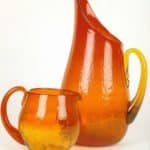
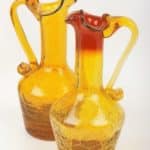
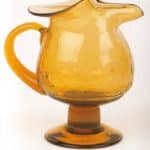

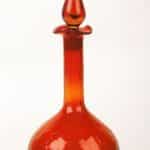

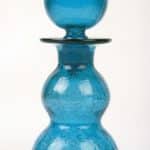
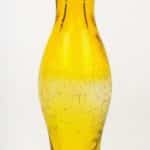
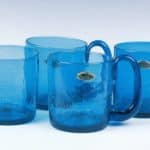
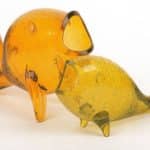
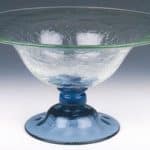
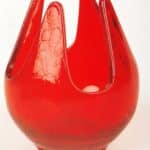




Related posts: